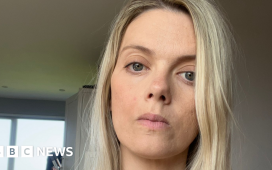The Hollywood celebrity originally had malignant cells removed in 2013. He has since undergone multiple treatments for basal cell carcinoma, a kind of skin cancer.
In a recent video posted to social media, Jackman, 54, stated that he will soon learn the results of his biopsy.
The Australian actor urged his 31 million Instagram followers and 15 million Twitter followers to always use sunscreen while sporting a plaster on his nose.
Each year, approximately 147,000 new cases of non-melanoma skin cancer are identified in the UK. It is more prevalent in older people and affects men more frequently than women.
A GP can examine your skin for signs of skin cancer. They may refer you to a dermatologist or a specialist plastic surgeon if they’re unsure or suspect skin cancer.
Here is what you need to know.
How to spot skin cancer
The NHS says there are two types — melanoma and non-melanoma type.
Melanoma
A new mole or a change in the appearance of an existing mole is frequently the first indication of skin cancer.
Normal moles are typically round or oval, have a smooth edge, and have a diameter of no more than 6 millimetres.
However, size alone does not always indicate skin cancer. A cancerous mole can have a diameter of less than 6mm, and a healthy mole can be larger than this.
Signs to look out for include a mole that’s:
- getting bigger
- changing shape
- changing colour
- bleeding or becoming crusty
- itchy or sore
It can appear anywhere on your body. But it most commonly appears on the back in men and on the legs in women. It can also appear in the mouth, on the bottom of the foot, under the nail, or in the vaginal region, but these melanomas are uncommon.
Non-melanoma
The term non-melanoma distinguishes these more common types of skin cancer from the less common type known as melanoma, which can be more serious.
The first sign of non-melanoma skin cancer is usually the appearance of a lump or discoloured patch on the skin that persists after a few weeks and slowly progresses over months or sometimes years. This is the cancer, or tumour.
How does skin cancer start?
Overexposure to ultraviolet (UV) light is the main cause of both melanoma and non-melanoma skin cancer. UV light comes from the sun, as well as from artificial tanning sunbeds and sunlamps.
Other risk factors that can increase your chances of developing non-melanoma skin cancer include: a previous non-melanoma skin cancer; a family history; pale skin that burns easily; a large number of moles or freckles; taking medicine that suppresses your immune system; and a co-existing medical condition that suppresses your immune system.
Is skin cancer curable?
Melanoma and non-melanoma skin cancer can often be treated. The treatment you have will depend on where the cancer is, if it has spread and your general health. Surgery is the main treatment for melanoma. Radiotherapy, medicines and chemotherapy are also sometimes used.
It could be challenging to treat advanced melanoma if you have been diagnosed with it. The cancer might not be treatable.
Your treatment in this case will focus on reducing the cancer and its symptoms while also extending your life.
What is the skin cancer survival rate in the UK?
Cancer Research UK said almost all (98.2 per cent) of people diagnosed with melanoma skin cancer in England survived their disease for one year or more between 2013 and 2017.
Also in this period, around 9 in 10 (91.3 per cent) of people diagnosed in England survive their disease for five years or more.










